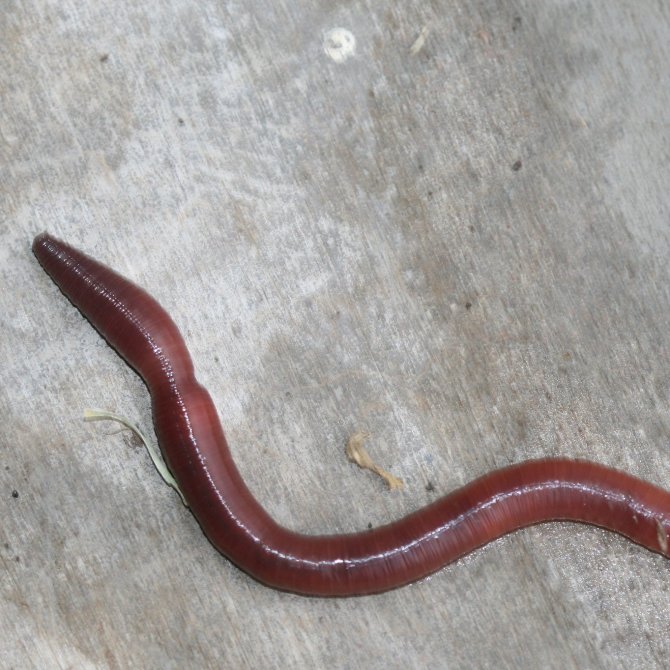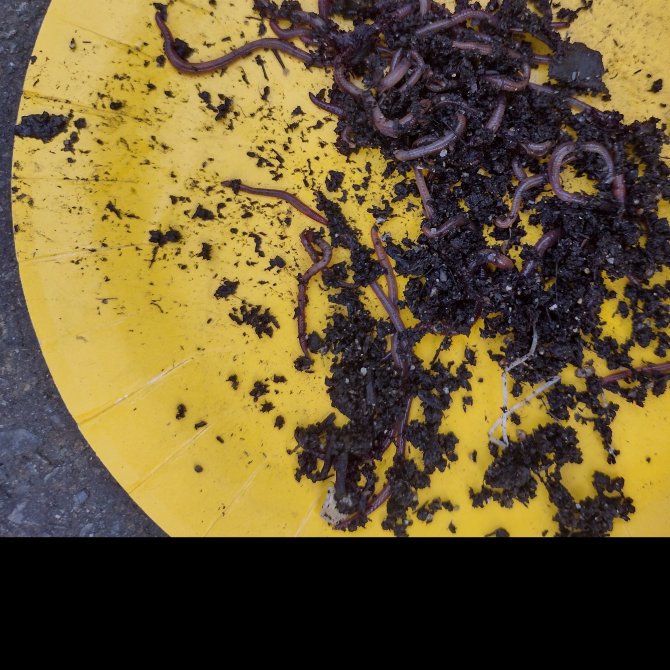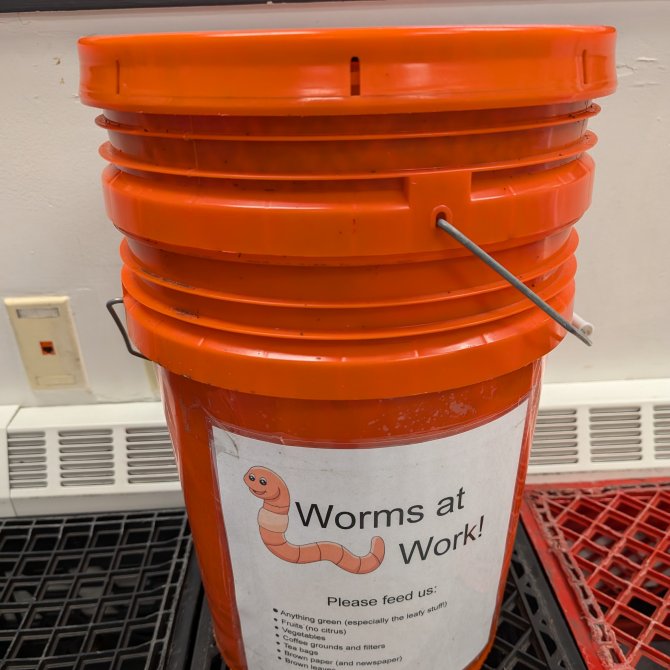
Expectations

Goal:
Students will gain a better understanding of vermicomposting and decomposition, as well as a better understanding of earthworm anatomy and how it aids in the decomposition process.
photo: Arthur Chapman, used under license CC BY-NC-SA 2.0
Objectives:
- Students will be able to identify the earthworm’s clitellum, and note that it separates the head section from the tail section of the earthworm.
- Students will be able to distinguish the “head” section of earthworms from the “tail” section, and describe which part will grow back if lost.
- Students will measure the length of the earthworms at the beginning of the lesson, and then again 2 weeks later. Students will then compare and graph their measurements.
- Students will be able to describe what happens to earthworms if improper materials are introduced into the compost.
- Students will be able to describe what will happen to the earthworms if the compost bin becomes overcrowded.
- Students will be able to define compost and decay.
- Students will be able to describe the lifecycle of earthworms.
Next Generation Science Standards:
- K-LS1-1. Use observations to describe patterns of what plants and animals (including humans) need to survive.
- K-ESS3-3. Communicate solutions that will reduce the impact of humans on the land, water, air, and/or other living things in the local environment.
- 1-LS1-1. Use materials to design a solution to a human problem by mimicking how plants and/or animals use their external parts to help them survive, grow, and meet their needs.
- 2-LS4-1. Make observations of plants and animals to compare the diversity of life in different habitats.
- 3-LS3-1. Analyze and interpret data to provide evidence that plants and animals have traits inherited from parents and that variation of these traits exists in a group of similar organisms.
- 3-LS3-2. Use evidence to support the explanation that traits can be influenced by the environment.
- 3-LS4-2. Use evidence to construct an explanation for how the variations in characteristics among individuals of the same species may provide advantages in surviving, finding mates, and reproducing.
- 3-LS4-3. Construct an argument with evidence that in a particular habitat some organisms can survive well, some survive less well, and some cannot survive at all.
- 4-LS1-1. Construct an argument that plants and animals have internal and external structures that function to support survival, growth, behavior, and reproduction.
- 4-LS1-2. Use a model to describe that animals receive different types of information through their senses, process the information in their brain, and respond to the information in different ways
- 5-LS2-1. Develop a model to describe the movement of matter among plants, animals, decomposers, and the environment.
Environmental Connection

This experience supports the following EPA priorities:
- Education: Community Projects - increasing young people’s understanding of the benefits of and participation in environmental stewardship related to clean water, soil and land revitalization, and management of ecosystem health. In an urban setting, this project will advance outdoor, place-based experiential education and community-based stewardship as the primary teaching tool.
- Environmental: Cleaning Up our Communities by Revitalizing Land and Preventing Contamination - supporting school-based composting and waste reduction education, educating young people about contaminants in urban waters, and engaging young people in developing solutions and action plans to revitalize the land, making the community safer and greener.
photo: Robyn Stewart
In this lesson, students learn that, in garden environments, various types of earthworms are beneficial; in certain forest environments, earthworms may invasive and cause extensive issues with erosion and destruction of the forest’s essential decay layer. The benefits of using red wiggler earthworms for classroom composting are discussed. Students learn how compost helps keep food scraps out of landfills, which not only helps create a cleaner environment, but also creates healthy nutrients for school based gardens.
Experience
Introduction:
The teacher introduces the lesson by reading Compost Stew, by Mary McKenna Siddals (for very young students, the teacher may choose to read Worm Weather, by Jean Taft, instead.)
Activity:
The teacher leads a whole group discussion about compost and vermicomposting. Students share their knowledge of what compost is, what should go into compost, what should not go into compost (and why), and how compost can help the garden.
photo: Melissa Fredricksen
The teacher discusses the anatomy of earthworms, their role in the environment as decomposers, and why certain foods are better to use when composting with worms. The teacher will note the fact that earthworms in New England are invasive, and while gardeners might love them for their garden soil, forests are being harmed by their presence. The students and teacher will also discuss the Asian Jumping Worm, whose population explosion has resulted in extensive soil erosion and destruction of the decay layer essential for many trees in New England.
Small groups of 3-4 students will receive the illustration of the anatomy of an Earthworm, the life cycle of an earthworm diagram, and a small container with a few earthworms. Students will observe the earthworms, looking for key external anatomical parts (clitellum, head, tail,) and use hand lenses to look closely at the earthworm’s muscle segments. Then, students will measure their earthworms, determine an average length, and record their findings on the Worm Bucket worksheet. Next, students will help to prepare the worm bucket for vermicomposting. Students will take turns adding moist paper towels, soil, food scraps, and earthworms. Finally: Students will write what was needed in the compost bin to make the worms happy on their Worm Bucket worksheet; they will make a prediction of what will happen over the following two weeks; and, will come up with three “I wonder” statements about their earthworms.
Worm bins will be kept either in the school yard garden or in the classroom. Students will add food scraps, weeds from the garden, and dried leaves as necessary. Students will also make sure that the worm bin is kept moist, but not too wet.
After two weeks, students will be placed back into groups, where they will be given a small container with earthworms from the worm bin. Students will measure their earthworms to see how much they have grown in two weeks. Students will observe the soil in the worm bin and note any changes on their worksheet. Students will hypothesize what has happened to the food scraps that were added to the worm bin.
Wrap up:
Students will use the compost created to fertilize the plants growing in the garden.
Extension:
Set up an experiment to compare plants grown with and without compost.
Materials Needed:
- Earthworm anatomical illustration
- Earthworm life cycle diagram
- Red Wiggler Earthworms
- 2- Five gallon buckets (one with holes drilled into bottom and screen added, plus lid with holes and screen.
- Vegetable and fruit scraps, dried leaves, weeds, used tea and coffee
- Dirt or garden soil
- Moist brown paper towels
- Containers for worm observation
- Rulers
- Magnifying glasses
- Book: Worm Weather by Jean Taft
- Book: Compost Stew by Mary McKenna Siddals
- Worm Bucket Worksheet
Exhibition

Creation and maintenance of the vermicomposting system, along with use of compost in the school garden, are authentic products of this project.
Student learning is assessed through small group discussion, whole group discussion, and evaluation of the Worm Bucket worksheets. Students are tasked with the care and feeding of the vermicomposter, and use the compost produced in their school yard garden.
photo: Robyn Stewart
Books
- Worm Weather by Jean Taft
- Compost Stew by Mary McKenna Siddals
